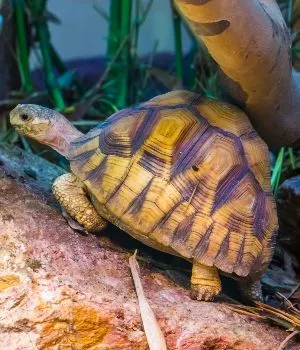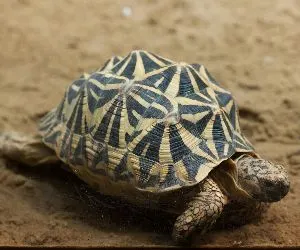All around the world, tortoises are depicted as gentle peaceful creatures and for the most part, this is true. These slow deliberate creatures belong to the family Testudinidae and are of the same order (Testudines) as other turtles.
While all tortoises are turtles not all turtles are tortoises. Only turtles within the family Testudinidae are tortoises. Other turtles include sea turtles and freshwater turtles.
Tortoises are generally rare and many species are endangered or threatened. As such, if you wish to keep a tortoise as a pet, make sure you obtain it through legal means.
You may also need to register your tortoise and have the right paperwork depending on the species. In this article, we will be looking at the rarest tortoises in the world.
Rarest Tortoises
1. Radiated Tortoise

- Scientific Name: Astrochelys radiata / Geochelone radiata
- Average Adult Size: 12 to 14 inches (25 to 36 cm)
- Max Adult Size: 16 inches
- Average Price Range: $1500 to $3000
- Conservation Status: Critically Endangered
Quick Care Requirements
- Diet: Foliage, leafy greens, and fruits
- Night/Shade Temperature: 55°F
- Basking Spot Temperature: 90°F
- Humidity: >50%
The radiated tortoise is one of the prettiest tortoises you will ever come across. This delightful tortoise has a carapace brightly marked with yellow lines that radiate from the center of each of the turtle’s carapace plates which is dark in color.
These radiating lines give this tortoise its common name. The radiated tortoise has a very limited geographic range which contributes to their rarity.
They are endemic to only the extreme southern to the southwestern part of Madagascar. They have however been also introduced to the Reunion island.
The radiated tortoise is severely endangered and is on the verge of extinction. As such they are quite expensive to acquire. Make sure you acquire a captive-bred only.
2. Angonoka Tortoise

- Scientific Name: Astrochelys yniphora
- Common Names: Ploughshare tortoise, Madagascar tortoise, the angonoka, or Madagascar angulated tortoise
- Average Adult Size: 12 to 14 inches (25 to 36 cm)
- Max Adult Size: 16 inches
- Average Price Range: N/A
- Conservation Status: Critically Endangered
Quick Care Requirements
- Diet: Foliage, leafy greens, and fruits
- Night/Shade Temperature: 55°F
- Basking Spot Temperature: 90°F
- Humidity: >50%
With a global population of just about 400 with only 100 adults in the wild, the Angonoka tortoise is one of the rarest tortoises in the world. This super rare turtle is native to Madagascar just like the radiated tortoise is.
The Angonoka tortoise looks very much like the radiated tortoise and even has similar needs. However, it is near impossible to find this turtle for sale. The critically endangered Angonoka tortoise is not a turtle you can acquire.
Females can reach lengths of 14.5 inches and weigh as much as 19 lb (9 kg). The males, on the other hand, can reach lengths of 16 inches. The Angonoka tortoise has a highly domed carapace which is light brown.
3. Spider Tortoise

- Scientific Name: Pyxis arachnoides
- Typical Adult Size: 7 inches (17 cm)
- Average Price Range: $900
- Conservation Status: Critically Endangered
Quick Care Requirements
- Diet: Leafy greens and Tortoise diet
- Night/Shade Temperature: 70 – 75°F
- Basking Spot Temperature: 88°F
The rare spider tortoise is so-called because of the web-like pattern on its dark carapace. These web patterns are yellow. Yellow spots adorn its head. Also, this tortoise has a yellow semi-hinged plastron.
The spider tortoise is highly endangered and can be found only in southwestern Madagascar. As a critically endangered species, only captive-bred specimens can be acquired by turtle enthusiasts.
Some places to find reputable tortoise breeders for this species include Reptmart, and the Turtle Source.
4. Galápagos Giant Tortoises

- Scientific Name: Chelonoidis nigra and other related species.
- Max Adult Size: 73.2 inches (187 cm)
- Max Adult Weight: 400 kg (880 lb)
- Average Price Range: N/A
- Conservation Status: Vulnerable to extinct in the wild
The Galápagos tortoise is one of the largest turtles in the world and the largest tortoise in the world. The largest Galápagos tortoise had a recorded length of 187 cm or 6.1 feet.
As you can see, this turtle is massive. Their massive size makes them easy to identify.
These tortoises may be found in zoos and are endemic to the Galápagos Islands which interestingly were named after the tortoise and not the other way around. Galápago in Spanish means tortoise and is the origin of this turtle’s common name.
The introduction of non-native animals to the Galápagos Islands and human exploitation has led to the near-extinction of most of the Galápagos tortoises. Conservation efforts are in place to ensure the Galápagos tortoises don’t go extinct.
Here are all the species that make up the Galápagos tortoise
- C. nigra (Floreana Island tortoise)
- C. microphyes (Volcán Darwin tortoise)
- C. hoodensis (Hood Island tortoise)
- C. guentheri (Sierra Negra tortoise)
- C. duncanensis (Duncan Island tortoise)
- C. phantasticus (Fernandina Island tortoise)
- C. porteri (Western Santa Cruz Island tortoise)
- C. vandenburghi (Volcán Alcedo tortoise)
- C. vicina (Iguana Cove tortoise)
- C. wallacei (Rábida Island tortoise),
- C. donfaustoi (Eastern Santa Cruz Island tortoise)
- C. darwini (James Island tortoise)
- C. chathamensis (Chatham Island tortoise)
- C. becki (Volcán Wolf tortoise)
- C. abingdonii (Abingdon Island tortoise)
5. Forsten’s Tortoises

- Scientific Name: Indotestudo forstenii
- Typical Adult Size: 10 inches (25 cm)
- Average Price Range: $250
- Conservation Status: Endangered
Quick Care Requirements
- Diet: Tortoise diet fruits, leafy greens, and occasional meat-based protein
- Night/Shade Temperature: 65-70°F
- Basking Spot Temperature: 90°F
This rare and exotic chelonian is such a gorgeous looking tortoise. This makes the Forsten’s tortoise a sought after turtle. Since they are rarely bred in captivity, they are quite rare to come across.
The chelonian is omnivorous and accepts a wide variety of foods. The shell of this turtle is ground colored with black blotches.
6. Travancore Tortoise

- Scientific Name: Indotestudo travancorica
- Typical Adult Size: 13 inches (33 cm)
- Average Price Range: $250
- Conservation Status: Vulnerable
Quick Care Requirements
- Diet: Tortoise diet, fruits, leafy greens, and occasional animal protein
- Night/Shade Temperature: 65-70°F
- Basking Spot Temperature: 90°F
The Travancore tortoise is one of the rarest tortoises you can find in captivity. As such they are quite expensive to acquire.
As with all threatened turtle species, make sure you acquire the Travancore tortoise from a reputable breeder. Only acquire captive-bred tortoises to protect the wild population.
Threats to the wild populations of the species include forest fires, habitat loss, and fragmentation.
The Travancore tortoise lacks a nuchal scut and a second cute along the vertebral column at the highest point of its carapace.
The tortoise has a white head with pink spots and a dark carapace with yellow lines along the scutes. The plastron of this turtle is also yellowish. The Travancore tortoise is the largest of the three Indotestudo turtles.
Some places to find reputable Travancore tortoise breeders are Reptmart and the Turtle Source.
7. Elongated Tortoises

- Scientific Name: Indotestudo elongata
- Typical Adult Size: 12 inches (30 cm)
- Average Price Range: $250
- Conservation Status: Critically Endangered
Quick Care Requirements
- Diet: Tortoise diet, fruits, and leafy greens
- Night/Shade Temperature: 65-70°F
- Basking Spot Temperature: 90°F
The Elongated tortoise is closely related to the Forsten’s tortoise and the Travancore tortoise. These three tortoises make up the genus Indotestudo.
This chelonian closely resembles the Forsten’s tortoise, although this chelonian is larger on average.
Because this turtle is tropical, if kept in a temperate zone, it is important to maintain the right temperatures. Low temperatures can easily cause the death of the chelonian.
8. Gopher Tortoise

- Scientific Name: Gopherus polyphemus
- Average Adult Size: 6 to 9.5 inches (15 to 24 cm)
- Max Adult Size: 16 inches (41 cm)
- Average Price Range: N/A
- Conservation Status: Vulnerable
Quick Care Requirements
- Diet: Foliage
- Borrow/Shade Temperature: 70°F
- Basking Spot Temperature: 90°F
- Humidity: 80%
The gopher tortoise may not be the rarest turtle in the world but it is quite rare. It is difficult to find this tortoise on the pet market. However, if you do get one, caring for it is relatively easy.
You must provide a large enclosure with a high humidity level and a burrow where the tortoise can cool off during the day. In the wild, this tortoise can create burrows with lengths of 50 feet although most have burrows of about 15 feet long. Each gopher tortoise thrives in about 4 acres of territory.
The gopher tortoise’s carapace is dark brown to gray-black. The plastron of this beast is yellow. Males have concave plastrons while females have flat plastrons.
The fall in the gopher tortoise population over the centuries is due to human predation especially in the early 20th century, being kept as pets (where they are unable to breed), and habitat loss.
9. Desert Tortoise

- Scientific Name: Gopherus agassizii
- Average Adult Size: 10 to 14 inches (25 to 36 cm)
- Average Price Range: $200 to $300
- Conservation Status: Vulnerable
Quick Care Requirements
- Diet: Foliage
- Borrow/Shade Temperature: 70°F
- Basking Spot Temperature: 90°F
- Humidity: 80%
The desert tortoise is closely related to the gopher tortoise as both belong to the genus Gopherus. As such, their care sheets are very similar.
Some refer to the desert tortoise as gopher tortoises although this is technically wrong. The desert tortoise is even the state reptile of California and Nevada.
If you wish to have a desert tortoise as a pet, I recommend adoption. There are many captive-breds out there that need new homes.
Due to the long lifespans of tortoises, it isn’t rare to find tortoises that need to be relocated. Since these tortoises live long, expect them to be with you for decades on end.
Some sites you can check for adoption include Arizona Game & Fish Department, Arizona-Sonora Desert Museum, and Tortoise Group.
10. Leopard Tortoises

- Scientific Name: Stigmochelys pardalis
- Typical Adult Size: 16 inches (40 cm)
- Average Price Range: $300 for babies, $3000 for adults
- Conservation Status: Least Concern
Quick Care Requirements
- Diet: Foliage and leafy greens
- Night/Shade Temperature: 70°F
- Basking Spot Temperature: 100°F
The rarity of this chelonian means that it is expensive to acquire. Nate to eastern and southern Africa, the leopard tortoise is the only tortoise in its genus Stigmochelys.
However, it’s not uncommon to find it placed in the genus Geochelone. The patterns on this tortoise’s shell resemble that of a leopard. This is where the chelonian gets its common name.
Conclusion
There are many rare tortoise species all around the world. While some species are rare because they are endangered and as such their wild populations are low, others are rare because they have a tiny geographic range.
Regardless, all captive tortoises deserve good care. Although tortoises are relatively easy to care for, they need a lot of space and protection against potential predators.
Since they are slow, they can easily be harmed by dogs and other animals such as raccoons. Also, they need specialized veterinarians. Lastly, as you are aware, tortoises live long lives and as such require a long-term commitment.
If you have any questions or additional information, leave us a comment.
